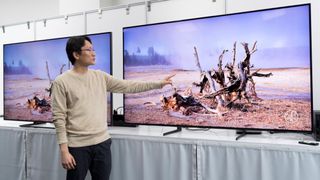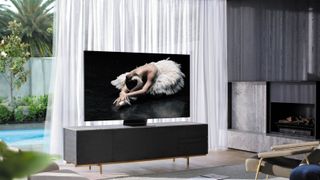
It’s been a good year for 8K TV sales in 2020. Sales numbers have doubled compared to 2019 and are set to have a similar rate of growth in 2021 – while a recent report by Deloitte predicts sales of about a million 8K TV units in 2021.
That success seems to be mirrored by an expansion of 8K TV ranges from the likes of Samsung and LG, with both TV brands doubling down on 8K sets, ensuring their highest-spec and highest-price models feature an 8K panel. All signs point to 8K being the TV technology of tomorrow then – but the full picture may not be as clear as these manufacturers would like.
Analyst Paul Gray, who leads Omdia’s TV research — a global firm that provides analysis across the technology ecosystem — says the Deloitte forecast is “highly optimistic”. Omdia’s own prediction is not nearly as upbeat as Deloitte’s:
“We expect 250-300 thousand 8K TVs to ship this year [2020], with around 600 thousand next year,” says Gray in an interview. “If we get to the million mark, it would need the Chinese market to take off, yet in China there is barely any 4K TV channels.”
Even the optimistic figure is a far cry from TVs porting the lower 4K resolution standard. In 2019 alone, a staggering 100 million units of 4K TVs were sold, making it the most popular resolution in the market, many times over – and leaving a lot of ground for 8K TVs to make up.
According to Omdia’s figures, about 19,000 sets of 8K TVs were sold in 2018. The figure increased by 100,000 in 2019 and reached more than 250,000 in 2020. In itself, it is staggering growth, but in comparison to 4K, the technology has a long way to go to catch up.
A long way to go

There are various reasons for this slower pace of adoption for 8K units. The cost, like any other new technology in its early days, is very high. That holds true even though costs have vastly reduced in the past few years. It has dropped swiftly, hence helping ramp up interest in 8K units.
Get daily insight, inspiration and deals in your inbox
Get the hottest deals available in your inbox plus news, reviews, opinion, analysis and more from the TechRadar team.
According to Deloitte, the average selling price (ASP) of 8K TVs in 2017 was more than $8,000 (around £5,900 / AU$10,600), going down to $5,500 (around £4,070 / AU$7,300) in the following year. It predicts a further reduction in 2021 to $3,300 (around £2,450 / AU$4,350), with entry-level units being offered for as low as $1,500 (around £1,100 / AU$2,000). However, when 4K TVs are available for less than $300 / £300 / AU$500, the disparity is still pretty large.
The next issue is the conundrum of inches. When it comes to such heights of resolution, size does in fact matter. A common argument is that in order to enjoy the full capacity of an 8K TV, you need the screen to be jumbo-sized.
“Screens have to be very large to get a real benefit and 80-inch class is still a rarity in all TV markets,” says Gray. “Most countries barely have 4K, and even then 4K services are not profitable. So what is the business case for a further technology step?”
Japan, perhaps, is the exception to that rule. One of the most ambitious players in the market is the country’s public broadcaster NHK. It launched a satellite channel dedicated to 8K content in December 2018, being an outlier at the time – and still to this day – in the support for the ultra-ultra-high resolution. A lot of the channel’s output is in nature and science documentaries, as well as sports programmes – all of which are common types of content to be pushing the limits of realistic detail.
The starting line

NHK had big plans for 8K this year, with its sights set squarely on broadcasting the Tokyo 2020 Olympics in 8K. Those plans have been put on ice, of course, due to the difficulties in hosting a mass sporting event in the midst of a pandemic, but NHK’s ambition is alive and well for 2021, with the Summer Olympics set to be hosted in Tokyo in August 2021 – and the Beijing 2022 Winter Olympics also on the cards for 8K broadcasts.
Many public broadcasters in Europe were expected to launch 4K channels (free to access) on satellite and/or streaming and perhaps some terrestrial, to start to capitalize on the mass implemented of 4K technologies in home televisions. With no Olympics or Euro 20 football to push on these channels, though, these plans have been pushed back to next year. And none of these broadcasters have a plan for an 8K service, according to Gray.
But NHK also has a longer vision – 300 million kilometres away from Earth to be precise. In a new collaboration with the Japan Aerospace Exploration Agency (JAXA), NHK is developing a super hi-vision camera to document JAXA’s Martian Moons eXploration (MMX) mission. This would be the first time for Mars and its moons to be recorded in 8K in proximity. Such blue sky (and beyond) projects, however, don’t have much of a bearing on sales of home systems.
It is not, however, all doom and gloom for 8K TVs. Like many other aspects of our lives, Covid has changed how we work and how we consume entertainment. We may not be able to go to the cinema, but there is plenty of drama to watch at home. There is already a number of 8K drama projects filmed by NHK and other players. Some international content shot natively on 8K include Amazon Prime’s Homecoming (Season 2), Netflix’s Money Heist (Season 4) and The Eddy, David Fincher’s Mank, and NHK’s A Stranger in Shanghai.

Live performances have fundamentally changed, becoming more accessible in the process. “Maybe 8K is a really good solution for professionally-organised performance playback – more than a consumer ‘at home’ format,” muses Gray.
With home-working becoming the norm for many, 8K tech can enhance our working lives, providing a real-life meeting atmosphere that might enhance the dreary experience felt by many. That, however, will be dependant on much faster, much more reliable internet connections. How many of us still struggle to watch TV in 4K Ultra HD without buffering and drops in resolution?
If you are following the growth of 8K TV sales with interest, you will have to look beyond 2021 for a full realization of the technology.
“Overall we remain very conservative about 8K as a TV format at home,” says Gray. “I think the original conception from the joint work between NHK and the BBC many years ago was right: soft launch 8K in 2025, with an aim of mass-market from 2030. That view still feels right: semiconductors and codecs would have advanced further, along with broadband speeds. Also, TV sets (assuming trends continue) would be bigger.”
Does that means it’s too early to buy an 8K TV? “I’m not saying never,” says Gray. “It’s just ahead of its time.”
- Best 8K TV: which should you buy?
